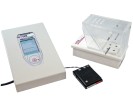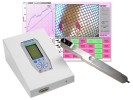Authors
YA Logashina, YA Palikova, VA Palikov et al
Lab
Shemyakin-Ovchinnikov Institute of Bioorganic Chemistry, Russian Academy of Sciences, Moscow, Russia
Journal
Marine Drugs
Abstract
Arthritis is a widespread inflammatory disease associated with progressive articular surface degradation, ongoing pain, and hyperalgesia causing the development of functional limitations and disability. TRPV1 channel is one of the high-potential targets for the treatment of inflammatory diseases. Polypeptide APHC3 from sea anemone Heteractis crispa is a mode-selective TRPV1 antagonist that causes mild hypothermia and shows significant anti-inflammatory and analgesic activity in different models of pain. We evaluated the anti-inflammatory properties of APHC3 in models of monosodium iodoacetate (MIA)-induced osteoarthritis and complete FreundÕs adjuvant (CFA)-induced rheumatoid monoarthritis in comparison with commonly used non-steroidal anti-inflammatory drugs (NSAIDs) such as diclofenac, ibuprofen, and meloxicam. Subcutaneous administration of APHC3 (0.1 mg/kg) significantly reversed joint swelling, disability, grip strength impairment, and thermal and mechanical hypersensitivity. The effect of APHC3 was equal to or better than that of reference NSAIDs. Protracted treatment with APHC3 decreased IL-1b concentration in synovial fluid, reduced inflammatory changes in joints, and prevented the progression of cartilage degradation. Therefore, polypeptide APHC3 has the potential to be an analgesic and anti-inflammatory substance for the alleviation of arthritis symptoms.
BIOSEB Instruments Used:
Rodent pincher - analgesia meter (BIO-RP-M),Electronic Von Frey 4 (BIO-EVF4),Static Weight Bearing Touch: Incapacitance Test (BIO-SWB-TOUCH-M),Electronic Von Frey 5 with embedded camera (BIO-EVF5)

 Pain - Thermal Allodynia / Hyperalgesia
Pain - Thermal Allodynia / Hyperalgesia Pain - Spontaneous Pain - Postural Deficit
Pain - Spontaneous Pain - Postural Deficit Pain - Mechanical Allodynia / Hyperalgesia
Pain - Mechanical Allodynia / Hyperalgesia Learning/Memory - Attention - Addiction
Learning/Memory - Attention - Addiction Physiology & Respiratory Research
Physiology & Respiratory Research
 Pain
Pain Central Nervous System (CNS)
Central Nervous System (CNS) Neurodegeneration
Neurodegeneration Sensory system
Sensory system Motor control
Motor control Mood Disorders
Mood Disorders Other disorders
Other disorders Muscular system
Muscular system Joints
Joints Metabolism
Metabolism Cross-disciplinary subjects
Cross-disciplinary subjects Happy new year 2025
Happy new year 2025 


